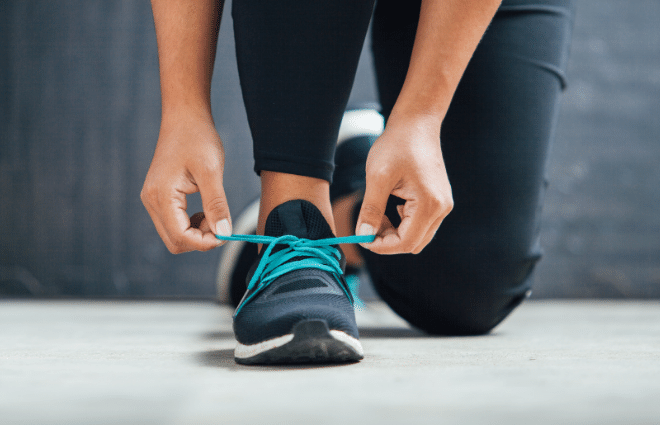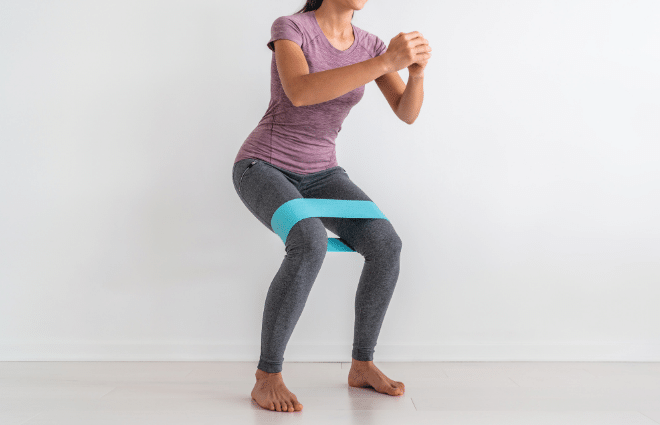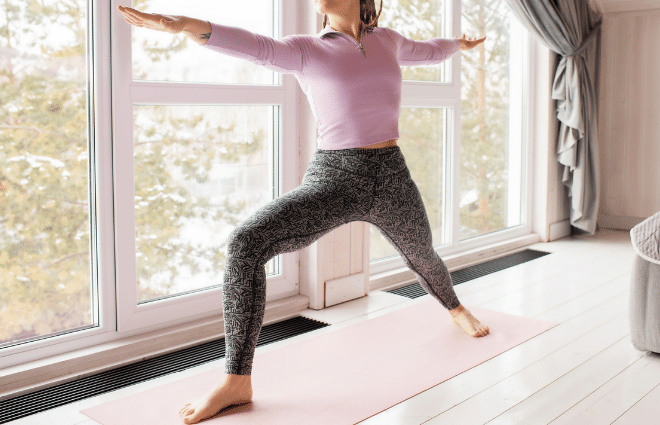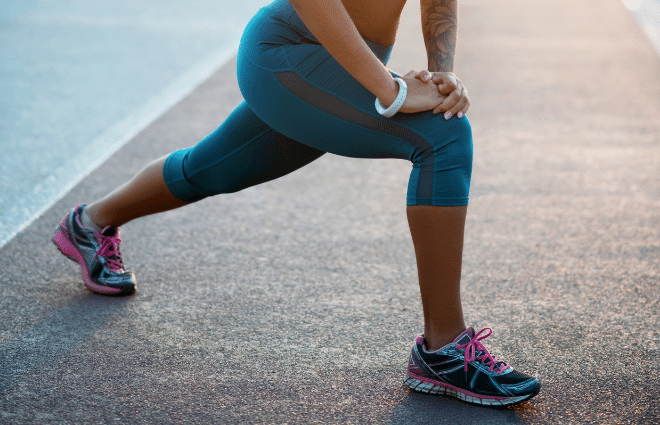How to Avoid Knee Pain While Working Out
[This is a guest post from Tim Fraticelli, blogger and founder of PTProgress.com. In this post, Tim shares his tips and experience for preventing knee pain while working out.]
Have you recently started a new exercise plan?
Getting back in shape is both challenging and rewarding, especially as you start to see results.
Some of those results might include muscle soreness, which is especially common if you haven’t exercised in a while.
But what about a nagging soreness or pain in your knee?
Unfortunately, 1 in 5 people experience knee pain (patellofemoral pain) sometime in their life.
If you’re up against knee pain when you exercise, don’t lose heart – or momentum – on your workout plan.
Take a look at these simple ways to avoid knee pain while working out.
This post may contain affiliate links, which helps keep this content free. Please read our disclosure for more info.
A Word of Caution on Knee Pain

As a physical therapist, I see a lot of people in the clinic with knee pain, but I always create customized exercise and treatment plans for each person because everyone is unique.
In the same way, use these tips as general information about preventing knee pain and consult your physician or physical therapist for a treatment plan that’s right for you.
Four Tips for Preventing Knee Pain
1. Start With the Right Shoes!

It’s great that you want to be more active and take up running, weightlifting, yoga, or other modes of exercise.
Just make sure you’re starting on the right foot by wearing the best shoes for the job!
When evaluating someone for knee pain, I always check their footwear.
Poor support at the feet can lead to a chain reaction of poor alignment up the leg and further stress at the knee.
Combine this poor alignment with repeated movements such as squatting or jogging and you’ll get a stressed knee and increased pain.
Still don’t think shoes are important?
Check out this research study, which found that footwear significantly affects how loads are transmitted through the knee!
What To Do?
If you’re starting a new activity such as running, invest in yourself by purchasing a high-quality pair of running shoes with excellent support.
For the best fit, buy shoes for your foot type and arch height.
And if you’re unsure, visit a local running store or see a physical therapist who specializes in running.
If you’re on a tight budget, consider buying supportive insoles instead to improve your running shoes.
2. Assess Your Form and Technique

You don’t need to be a physical therapist or a personal trainer to understand the importance of having proper form when exercising.
A few basic tips can help decrease knee pain and even prevent injury in the first place.
Avoid Knee Collapse
Knee collapse happens when you allow your knees to cave inwards while performing exercises such as squats and lunges.
This failure in form is one of the biggest errors I witness in the clinic and is one of the leading causes of knee pain and injury.
To avoid knee collapse, keep your knees aligned vertically with your heels, even if that means modifying the intensity of the exercise.
Maintain Good Posture and Alignment
Before performing an exercise, always take a few seconds to “square up” into a strong athletic stance:
- place your feet shoulder-width apart
- and engage your abdominal muscles.
Getting your setup correct before performing your squats, jumps, or lunges will encourage better posture and prevent pain and injury.
Yoga is also a great exercise to help you build strong form and posture, while avoiding injury.
Watch Quality Over Speed
Faster isn’t always better.
I’d much rather see someone perform 8 controlled squats than 12 sloppy ones.
Remember this saying: “you get what you train.”
By training poor quality movements, you’re setting yourself up for injuries in the future.
So instead of speeding through your workout, focus on quality movements – your knees will thank you later.
3. Strengthen Around the Knee

Did you know there are more than 10 muscles that cross over the knee joint and help you flex and extend your knee?
While it’s important to strengthen the common muscle groups such as the quads and hamstrings, it’s equally important to consider the muscles above and below the knee.
Work Muscles Above the Knee:
If you want to prevent knee pain (or even treat a painful knee), make sure you strengthen your hip muscles, or glutes.
Strong glute muscles help control alignment and rotation of the lower leg.
But if they’re weak, these muscles can lead to poor alignment and additional stress on the knee.
To strengthen the glute muscles, incorporate a few hip stabilization exercises such as clamshells, sidesteps, hip kicks, and lateral step-ups.
Work Muscles Below the Knee:
Don’t forget about ankle stabilization exercises!
A stable ankle provides a strong base of support for your knee, improving your balance and preventing further knee injury.
Practice single-leg stances on a soft surface and use a resistance band to strengthen the ankle through all 4 planes of motion.
4. Consider Cross Training

When you start to experience knee pain from exercise, it’s important to figure out the root cause of the issue.
Some modes of exercise are more stressful on the knee than others.
For example, running (or jogging) is one of the most common activities people use to start exercising again.
It’s simple, free, and easy to perform almost anywhere.
But if knee pain is keeping you from tying up your laces, consider a new mode of exercise.
It’s important to stay active, so find a few cross-training activities that will get your heart rate up but also bring your knee pain down.
Even if you aren’t experiencing knee pain, it’s always good to mix up your routine with some cross-training.
Yoga
Performing 30 minutes of yoga is a great way to vary your exercise routine.
The benefits of yoga are multitude: not only will you improve your stability with balance exercises, you will also strengthen your legs and trunk muscles without further stressing your knee.
If you’re new to yoga and ready to get started, check out Avocadu’s Yoga Fat Loss Bible.
It provides detailed instructions and beginner modifications for your practice, plus a 6-week workout plan any beginner can start with.
Swimming
A great cardiovascular exercise, swimming is one of the best low-impact movements you can perform when rehabbing your knee.
Biking
Another good, low-impact activity is biking.
This will strengthen the quads and give your knees a break from high-impact exercises such as running or jumping.
Rowing
With rowing, you can build strength in your lower extremities without pounding the pavement.
Rowing is also a great cardio exercise and an excellent challenge for upper body strength as well.
Bonus: Compact rowing machines fold up, and take up a lot less room than treadmills or most other in-home cardio equipment.
Final Thoughts

While knee pain is very common among active people, it doesn’t have to be a long-standing issue that you just “live with.”
By changing up your routine and considering a few factors such as form and footwear, you’ll set yourself up for a lifetime of being active – without that nagging knee pain.
About the Author:

Tim Fraticelli, DPT MBA, is a Physical Therapist and founder of PTProgress.com.
PTProgress provides career development resources for Physical Therapists to improve their lives in and out of the clinic.

You might notice that knee pain sufferers cover their knees when exercising or other occasions. Gotlin states that most people do this as it feels good. While it’s unlikely to harm your knee, it will not aid in avoiding injury. If you wrap, make certain to not wrap too tightly, as this could cause knee issue.
Such an informative and elaborate post to treat knee pain, thanks a lot, it was very helpful!